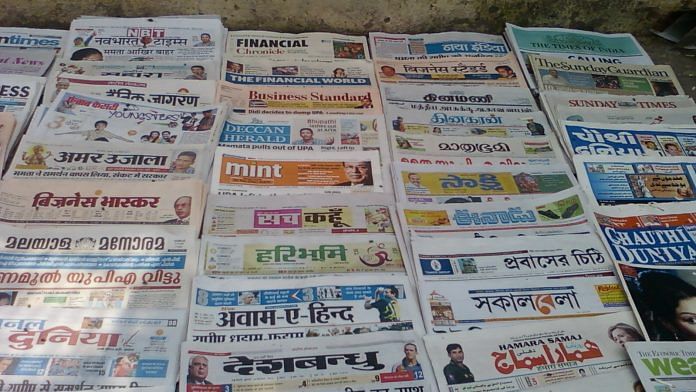New Delhi: Media organisations have been laying off staff, cutting salaries and stopping publications. It seems like the first thing the pandemic has hit around the world is the news media business.
We have heard about big names like the The Times of India, The Quint and The Indian Express doing so, but the situation must be much worse for smaller, regional organisations.
It may seem like it’s a good time for media organisations. The audience is sitting at home waiting for content and there is a lot of content available to produce. However, a person with some understanding of how these organisations work will know that times are really grim for the media.
Also read: Job losses, pay cuts, editions shut — coronavirus triggers new crisis for Indian media
A broken business model
Most media organisations depend on advertising. However, as a result of Covid-19 and its impact on the Indian economy, businesses are unwilling to advertise their products. Nobody will buy their products in a lockdown and the first cost that companies cut is on advertising.
To understand how much these organisations depend on advertising, we look at the leader in the industry, The Times of India. It sells the most number of English newspapers in the world. Even after being the largest organisation, The Times of India group’s turnover is just over Rs 10,000 crore. In 2018, its profit was Rs 681 crore. This profit is minuscule compared to the market leaders in other industries. Even Havells, a fairly new electronics company, makes a larger profit than the The Times of India, and this has consequences.
A long newspaper, like The Times of India, has 48 pages. The newspaper is sold for around Rs 5 and about 40 per cent is taken by distributors. The media organisation gets around Rs 2.40. Now each page costs Rs 0.25 to print and printing 48 pages costs Rs 12. A very conservative cost of paying employees and news agencies etc is Rs 3.
So if newspapers are produced at Rs 15, how are they sold at Rs 5 and how is profit still generated? The answer is ad revenue.
Since Samir Jain of Times of India based the company’s business model on ad revenue, it has become the industry’s standard. His company became the market leader and everyone had to follow his model to survive. Newspapers are sold cheaper and cheaper, and revenue is earned from ads.
However, there is no contradiction between good journalism and the marketplace. But it is a distorted market, which has been distorted by the market leaders. In the short run, when the economy is good, the flaw in this model doesn’t show.
TV news channels
TV news channels follow the same model, but the flaw is even more evident there. India has nearly 900 TV channels and half of them are news-oriented.
Nearly all English TV news channels run in losses. They are either subsidised by Hindi channels or they are not run for profits but for some other reasons.
News channels are very cheap, so they are even more dependent on ad revenue than newspapers. A channel subscription is Rs 2 or 3 a month, whereas a single newspaper costs more than that.
Businesses advertising in news channels also advertise on entertainment and sports channels. So very little of their marketing budget is left for news channels. Then the distributors take a large share of the ad revenue. This leaves news channels small and unprofitable and they are hit very hard when businesses cut their advertising budget.
As mentioned earlier, media organisation are minuscule as compared to companies in other industries. During the economic boom of 2007-08, businesses in many industries had large profits and they could spend a small fraction of it to buy media organisations. One such industry is the mining industry, during the mining boom, they could easily throw away a few crores to start or buy a media organisation.
As a result, many media organisations had come up in Odisha and Chhattisgarh.
Also read: Not just Ramayan, news programmes on TV also topping charts — over 200% jump in viewership
Digital News
Coming to digital news, this industry is an even more extreme version of print newspapers and news channels. Here, the reader doesn’t pay anything at all. The organisation is solely dependant on ads. Distributors like Facebook and Google take most of the ad revenue and a very small fraction is left for the organisation.
The model cannot work and companies who have adopted these will be most stressed at these times. This business model is broken.
Good articles have to be paid for and people in the West are realising this. Even in India, The Hindu focuses on quality and doesn’t keep cutting their prices. In fact, Hindu has consistently raised the price of their newspaper and yet has done very well.
A new contract has to be established between good journalism and the audience.
Watch the latest episode of CTC here:







CTC 452: I think you need to expand on this theme. I would like to also think that good media will win but I am not sure.
Dependent it is , not dependant as you have spelled or spelt it.
Really Like the way you candidly presented the CTC Episose 452 .
Thank-you
take care
regards